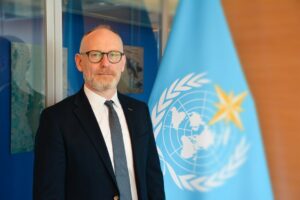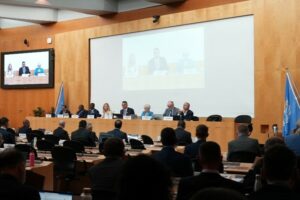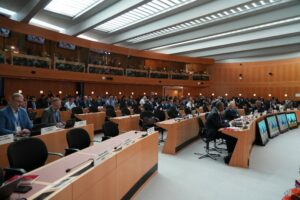A detailed road map to provide early warnings against dangerous natural hazards for everyone on the planet and an implementation plan for a new Global Greenhouse Gas Watch initiative were top the agenda of the annual World Meteorological Organization (WMO) Executive Council, which took place earlier this month.
Met Éireann’s Director Eoin Moran has been leading the ‘Early Warnings for All’ initiative since elected as second Vice-President of WMO a year ago. At the June Executive Council he chaired the sessions that led to the Early Warnings for All road map adoption by the WMO Council, as well as the adoption of relevant measures for the the Greenhouse Gas Watch (G3W) Cryosphere initiatives.

Met Éireann Director and 2nd Vice-President of WMO Eoin Moran at WMO Headquarters in Geneva
Eoin Moran says:
“As weather extremes, climate impacts and economic losses occur with increasing regularity, we now have a clear eyed vision of the urgent need for early warning systems to support and protect, the citizens of least developed countries and small island developing states who are the most vulnerable globally to the damaging effects of climate change.”

Eoin Moran, presentation podium, second from right, alongside fellow chairs at the WMO Executive Council, Geneva, June 2024
Early Warnings for All
The WMO Road Map for the Early Warnings for All initiative outlines the vision, objectives and actions to enhance the delivery and use of multi-hazard early warning systems for weather, climate, and water-related hazards. It covers the period from 2024-2027 with detailed dates and deliverables.
Early warning systems have helped decrease the number of deaths and have reduced losses and damages resulting from hazardous weather, water, or climate events. They provide a nearly tenfold return on investment. But major gaps still exist, especially in small island developing states and least developed countries. Some 70% of all deaths from climate-related disasters have occurred in the 46 poorest countries over the past 50 years.
The Early Warnings for All initiative is co-led by WMO and the United Nations Office for Disaster Risk Reduction (UNDRR), with support from the International Telecommunication Union (ITU), the International Federation of Red Cross and Red Crescent Societies (IFRC) and other partners.
WMO is responsible for the pillar on detection, observation, monitoring, analysis and forecasting.
This aims to close critical gaps among WMO Members and Territories, as illustrated by the following challenges:
- Only a third of WMO Members and Territories report having multi-hazard monitoring and forecasting system.
- Critical gaps in surface and upper air meteorological observations across Africa, parts of the Pacific and West of Latin America.
- 67 per cent of WMO Members report having warning and alerting services available 24/7.
- Of the 30 countries initially selected for Early Warnings for All coordinated assistance, half of the National Meteorological and Hydrological Services (NMHS) currently operate with basic monitoring and forecasting capacity and close to a quarter with less-than-basic capacity.
The road map seeks to leverage the entire WMO network and enhance the capabilities of its NMHSs to protect lives and livelihoods. WMO Members have already endorsed the structure underpinning the priority activities, with defined roles and responsibilities.
The Executive Council has examined the strategic rollout plan consisting of two pivotal phases: the catalytic phase and the sustained action phase:
- During the catalytic phase, countries identify gaps and mobilize stakeholders to accelerate universal multi-hazard early warning system coverage through national road maps.
- This is followed by the sustained action phase, which focuses on collectively implementing road maps and enhancing capabilities.
Although 30 focus countries have been prioritized, the initiative is being expanded to other countries in order to meet the demand and need. The road map will guide WMO as it seeks to scale up and accelerate actions.
An EW4All Dashboard was launched at COP28, providing transparent and continual monitoring of progress on the initiative.
The WMO Road Map has specific provisions on building capacity and resilience, based on an inclusive and people-centred approach. It emphasises the sovereignty of national authorities, whilst stressing the need for coordination, integration and alignment in order to pursue rapid action at unprecedented scale. Coherence, consistency, accountability and sustainability are paramount. It seeks to leverage technology and innovation such as Artificial Intelligence to accelerate progress.

WMO Executive Council members at the recent meeting in Geneva
Global Greenhouse Gas Watch
The Global Greenhouse Gas Watch (G3W) aims to support WMO Members in mitigation actions undertaken to implement the Paris Agreement. It seeks to fill critical information gaps and provides an integrated, operational framework that brings under one roof all space-based and surface-based observing systems, as well as modelling and data assimilation capabilities in relation to greenhouse gas monitoring.
Initial focus will be on the three most important greenhouse gases influenced by human activities, namely carbon dioxide, methane, and nitrous oxide. It takes into consideration both human and natural influences on the levels of greenhouse gases in the atmosphere. The system will be built on the basis of the long-term efforts of WMO in coordination of greenhouse gas observations and research.
The need for improved monitoring to support mitigation is highlighted by a new report from scientists from the US National Oceanic and Atmospheric Administration and the Scrips Institution of Oceanography at the University of California, San Diego.
Levels of carbon dioxide (CO2) measured at NOAA’s Mauna Loa Atmospheric Baseline Observatory by NOAA’s Global Monitoring Laboratory surged to a seasonal peak of just under 427 parts per million (426.90 ppm) in May, when CO2 reaches its highest level in the Northern Hemisphere. That’s an increase of 2.9 ppm over May 2023, and the 5th-largest annual growth in NOAA’s 50-year record.
When combined with 2023’s increase of 3.0 ppm, 2022 to 2024 has seen the largest two-year jump in the May peak in the NOAA record.
The WMO Infrastructure Commission (INFCOM) approved the Global Greenhouse Gas Watch Draft Implementation Plan at its session in April, which the WMO Executive Council then discussed.
One important aspect of the Executive Council resolution on g3W is the recommendation for any greenhouse gas monitoring to be carried out with “full transparency,” in accordance with WMO’s fundamental policy for free and unrestricted international exchange of Earth system data.
Specifically, it aims at further strengthening collaboration and coordination with relevant UN agencies and other international partners engaged in greenhouse gas monitoring and modelling activities, mobilizing partner resources and ensuring equal access for all Members to WMO resources, including means to ensure global comparability of GHG monitoring data.
It stresses the need for engagement with stakeholders at international forums, such as the Conference of the Parties to UNFCCC (COP), to promote the uptake and use of the data and products generated by this infrastructure.
The resolution envisages a joint advisory group, co-chaired by INFCOM and the WMO Research Board, to guide the implementation of the plan, with the appropriate involvement of external stakeholders.
For more information on WMO Executive Council’s June meetings and resolutions, please see:
Early warnings and greenhouse gas monitoring top WMO Executive Council agenda